The Anatomy of Marketing
This blog was written by Kieran Antill & Ross Hastings from Ne-Lo - a business design consultancy that partners with mid-sized and scaling businesses to achieve sustainable growth through organisational alignment, marketing effectiveness, and optimised customer and employee experience.
They combine evidence-based strategy, award winning creativity, and focused research to optimise your brand experience end-to-end. View their StudioSpace profile here.
The biggest reason for any company falling short of its full potential is the inability to adopt a company-wide approach to marketing, according to our research with 186 executive leaders.
There is clearly some nuance behind that statement, which this article will highlight and discuss in more detail. But first, some context.
Like us, you’ve probably found that there is a tsunami of marketing advice out there, some well-evidenced, most well-intended, but all together it is a confusing mess. It’s not unusual (or surprising) for companies to be misaligned on the role of marketing within their organisation.
As a result, there is a pressing need for an agreed set of marketing fundamentals and clarity on how they all connect. Even more importantly, how it can all be operationalised in modern businesses where marketing occurs across multiple business units. No two businesses are the same, so it’s important that these fundamentals enable executive teams to articulate the role and expectations of marketing in their organisation and be able to align a complex and ever evolving system around that.
That’s what The Anatomy of Marketing aims to provide. This isn’t about re-inventing the wheel and it’s certainly not about adding more models. It’s about bringing together the best of what we know and showing how it works as a system so that companies can build company-wide alignment based on a common understanding of marketing.
Establishing Common Language
Whether it’s an industry debate or a discussion at an exec. meeting, we lack common understanding and shared language of marketing. This causes major problems as we all say the same words but mean different things. Worse, we walk away thinking we mean the same thing. So, before going any further - let us clarify what we mean by marketing for the purposes of The Anatomy of Marketing.
Marketing is a culture, not a department
Although we’ve had any number of Ps, Es, and Cs thrown at us over the years, Jerome McCarthy’s good ol’ 4Ps (Product, Place, Price, Promotion) from 1960 still hold up today. There is rarely (but not never) a need to complicate things beyond this. The main difference is that in modern business, these 4Ps are spread across multiple departments or business units, meaning marketing cannot be confined to a single department.
The chances are, you work in a marketing organisation
In a post-industrial economy, most businesses are marketing organisations. Unless you’re from an industrial company, or primarily focused on manufacturing, mining, or oil & gas - the chances are you’re in a marketing organisation. Whether or not it operates like one is another story.
There are marketers in all business units
The Cambridge Dictionary states that “The marketer has to understand the reasons why people behave as they do”. Merriam-Webster goes with the (perhaps not particularly earth shattering); “A marketer is someone whose job involves marketing.” but the subtext they add is more thought provoking; “As a marketer I understand what makes people buy things.”. Nowhere does it stipulate that this person must exist in a marketing department.
Marketing is cause, brand is effect
Perhaps one of our more contentious positions, we suggest that you can control marketing; it’s any decision you make, investment you prioritise, resource you allocate, or lever you pull that impacts customers (or potential customers). Brand is the result of all of that, while you can (and should) articulate what you want your brand to be, you can’t control it. It is literally the perception customers have of your company as a result of your marketing. Measure it in order to optimise marketing efforts.
Brand equals the reputation of your business
Related to the last point - but worth emphasising - brand is nothing less than the reputation of your business. Framed like that, it’s hard to argue its absolute critical value to any business, large or small, private or listed, start up or centuries old, and B2B or B2C. It’s what the people that matter most to you think about and say about your business and how they choose to interact with it (or not).
So, with that as our frame of reference, let’s return to our discussion and ask……
Why Do We Need Company-wide Marketing Alignment?
The terms “Customer First”, “Customer-centric”, and even “Customer Obsessed” are sprinkled, liberally, through modern corporate strategies. But they almost always fail to take into account the sheer complexity of the ecosystem that exists between any company and its customers.
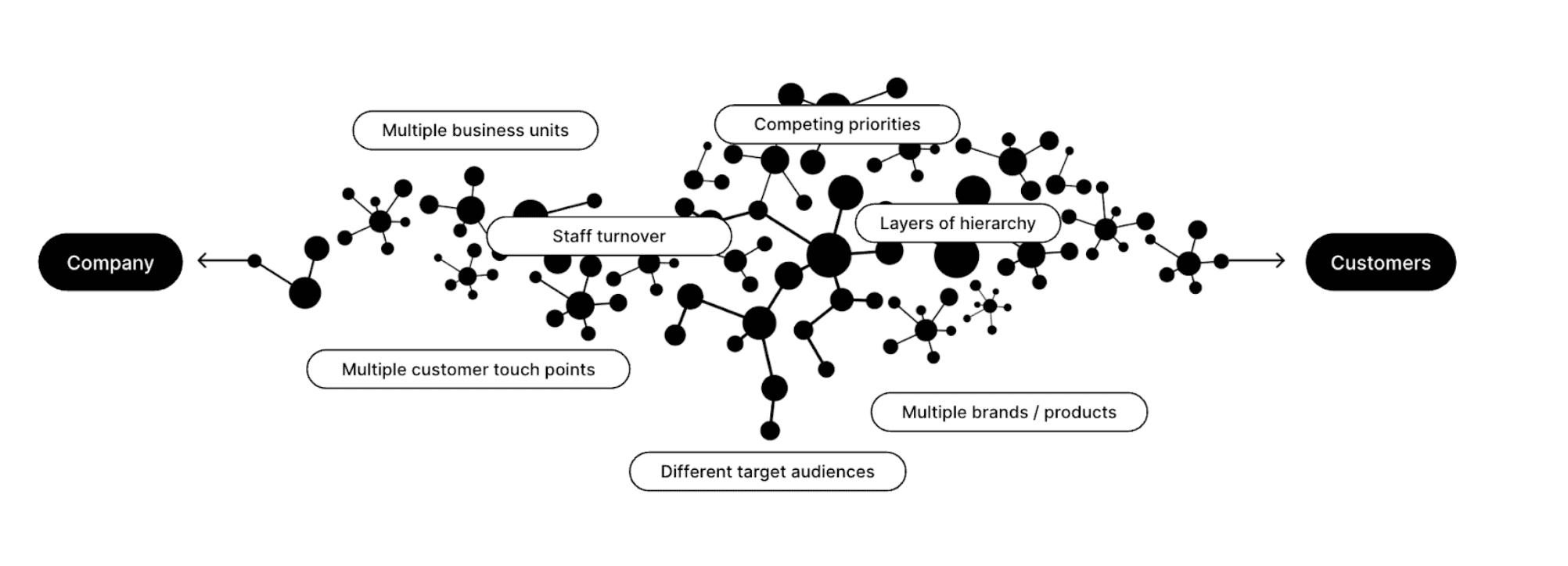
I’m sure the system looks familiar. It consists (among other things) of multiple business units and layers of hierarchy, numerous customer touch-points across different target audiences, potentially multiple brands and products, and certainly competing priorities and staff turnover. These factors are neither positive or negative……they just are.
The executive team at Ne-Lo Business Design decided to explore this further and ask ourselves; “How might we better support companies to create consistent, quality experiences at scale?”. We interviewed and surveyed 186 executive leaders (to date) - including CMOs along with numerous other roles such as CEO, and heads of product, sales, brand, and customer experience - to better understand this challenge.
Three prominent themes emerged from and were reinforced by this research, consistent across all executive roles and types and sizes of business.
Challenge 1 - Lack of common language and shared understanding of ‘marketing’ across the organisation
Related to our earlier point about common language; leaders shared that their companies lacked a shared understanding of what marketing is and the role it plays in their organisation.
Challenge 2 - Siloed customer ownership leads to inefficient investment of time and capital.
Time and again, leaders described a situation where different business units (often marketing, product, and sales) commissioned research and strategy projects, duplicating investment and ultimately leading to a fragmented view of customer and inconsistent customer experience.
Challenge 3 - Measurement for the sake of measurement, without informing focus or prioritisation
In a world where Google, Meta and others offer the ability to measure everything to the nth degree, not a single leader identified a problem with lack of data. Instead, they described having too many measurements, and multi-page reports that failed to provide the insight required to focus attention and prioritise investment,
Below, we can see to what extent each challenge resonated across the entire cohort of leaders engaged.
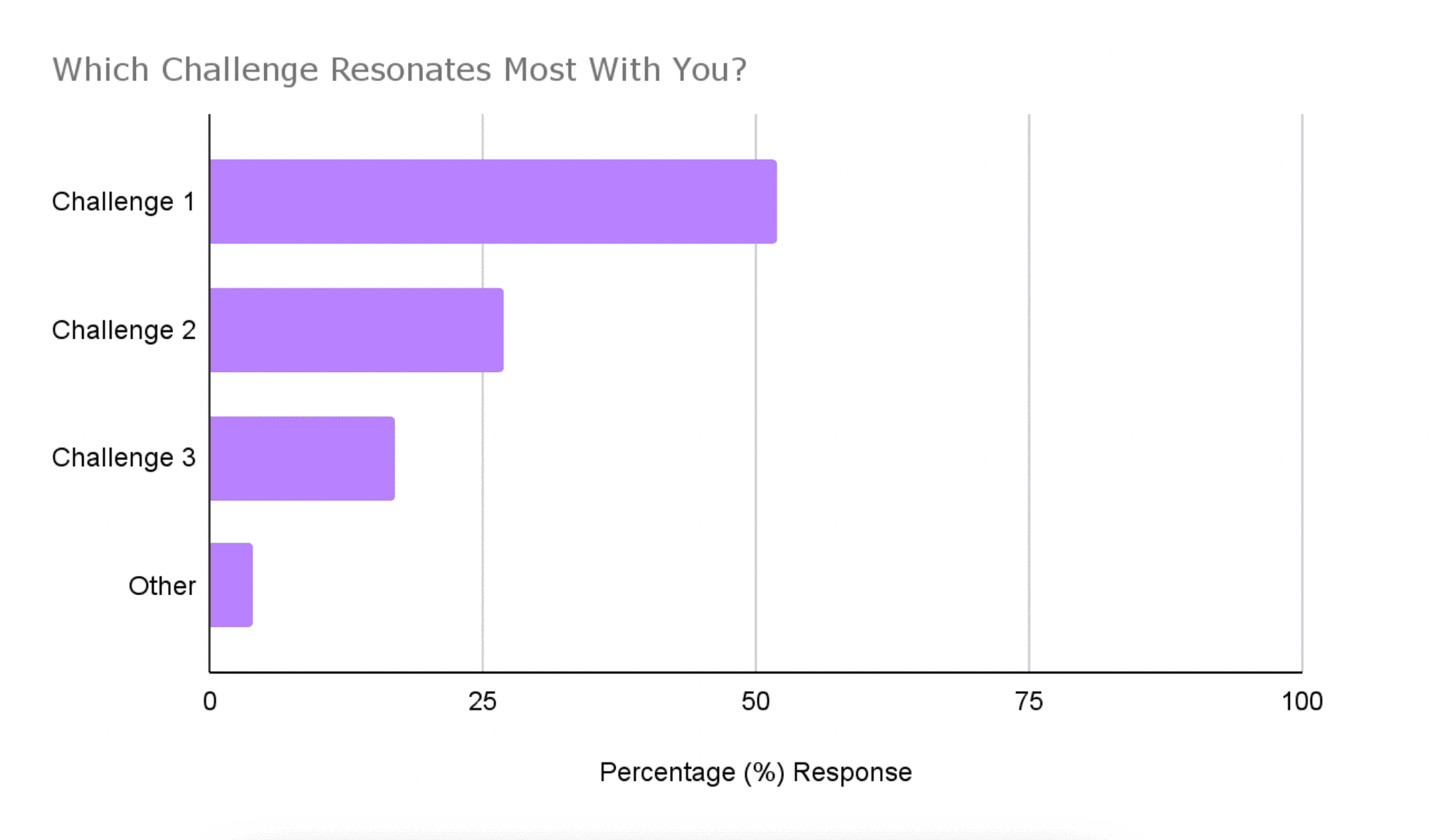
These findings point to a company-wide approach to marketing being critical in clarifying the role and expectations of marketing in a business, the ownership of different decisions that affect customers, and the way success is measured in order to enable focus and prioritisation. Which brings us onto The Anatomy of Marketing.
The Anatomy of Marketing
Built on evidence-based fundamentals, The Anatomy of Marketing is a combination of model, mindset, and methodology that supports clear diagnosis, alignment of priorities, and the delivery of connected marketing projects that focus innovation and build cumulative value. Every company has the same fundamental anatomy but how you treat it can lead to very different results.
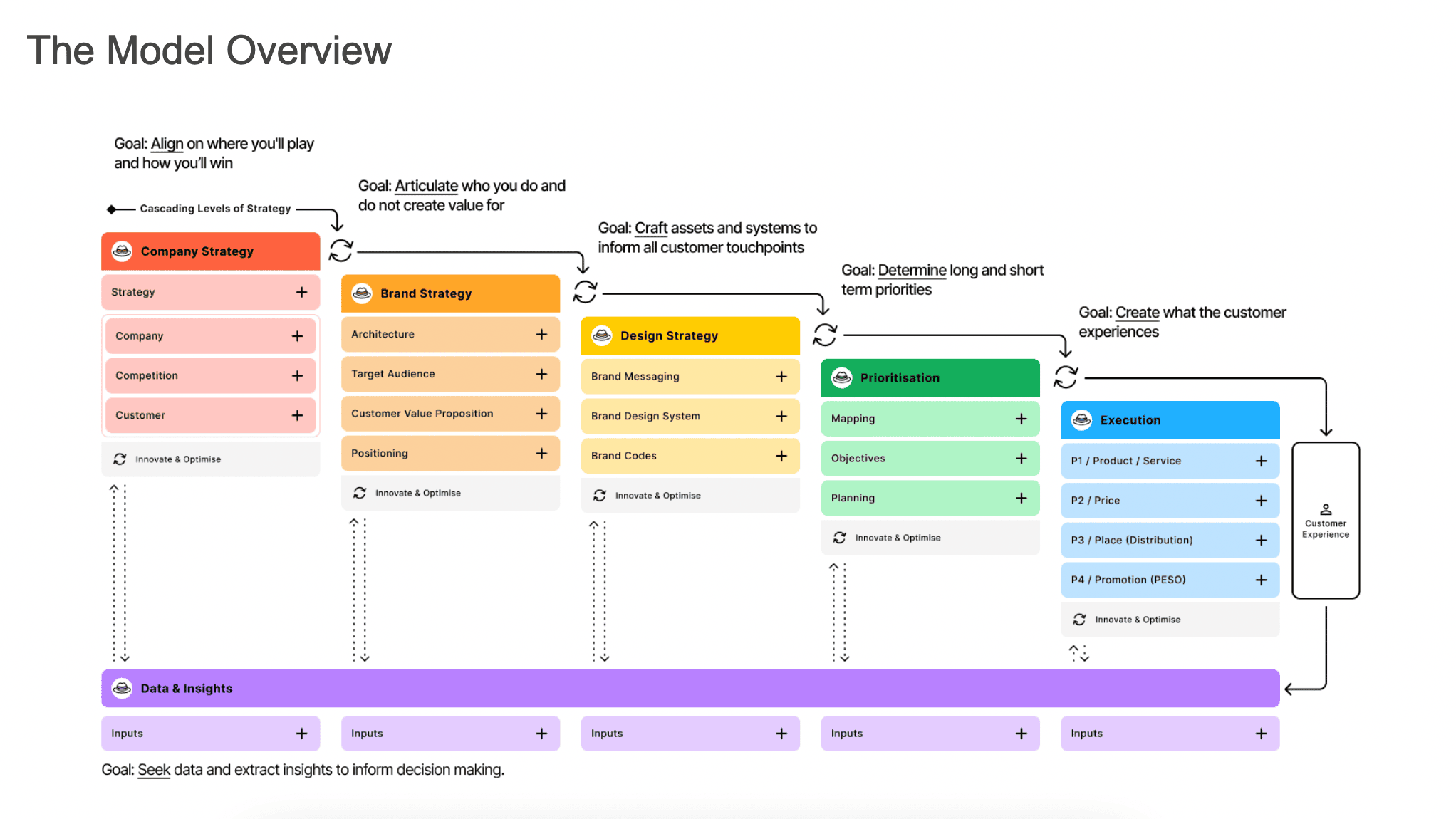
The Model Overview
The model itself provides the overarching structure to support company-wide alignment. There are some key features that enable this:
Firstly, the cascading levels of strategy allow an executive team to connect and optimise decisions through various levels of their organisation and avoid disconnects between corporate strategy, marketing strategy and
The coloured hats replace traditional departmental labels and support a collaborative approach to decision making. Decision roles can be articulated, and discussions facilitated with the clear context of what hat is being worn.
Data & Insights are called upon from the right people, at the right time, to support focused decision making and prioritisation. Rather than one 150-page research report that is supposed to inform any and all customer decisions across the organisation.
The overall model highlights just how much work is done behind the scenes of what the customer actually experiences. This is what navigating that complexity between company and customer actually looks like.
Finally, it’s worth highlighting that this doesn’t work as a waterfall in the real world of business. Unless you’re sketching out a business concept on the back of a napkin, this system is already in play and this model should be used as a way of aligning on where innovation and optimisation opportunities exist. Which brings us nicely on to The Anatomy of Marketing methodology.
The Methodology
**Diagnose **> Prioritise > Build > Innovate
The role of the methodology is to support clear diagnosis, alignment of priorities, and the delivery and innovation of connected projects that build cumulative value.
It is partly about the 4-part process itself, but more about how The Anatomy of Marketing model and connected system of frameworks give rigour to that process. We’ll give a brief overview of how that works here.
Diagnose > Prioritise > Build > Innovate
Firstly, as discussed, the model itself provides a highly effective shared view of marketing fundamentals in order to diagnose key issues as an executive team. One of the things we’ve found most striking when using The Anatomy of Marketing either with clients or in keynote workshops, is how effective it is in building alignment around where key issues or opportunities exist.
Below, you can see the collapsed view of the model, showing the key projects that sit under each hat.
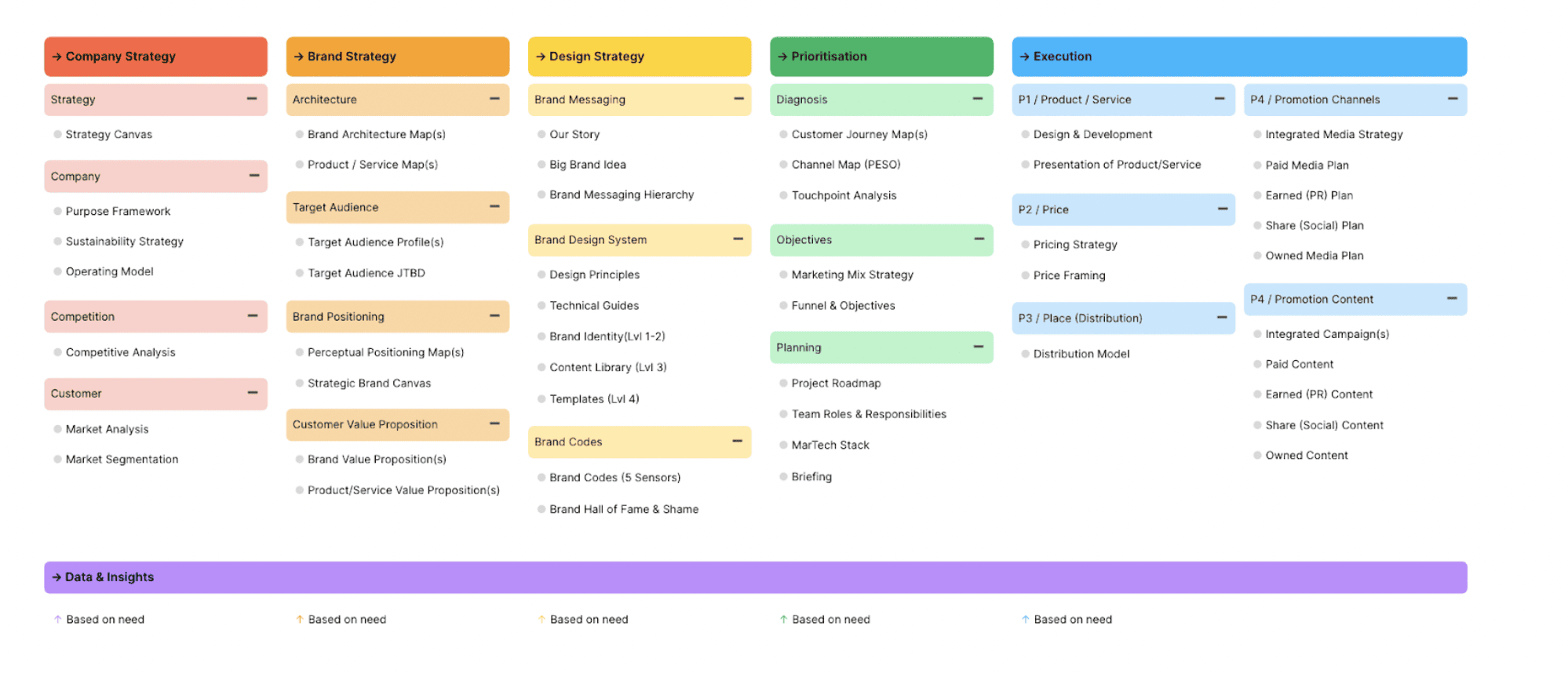
Diagnose > Prioritise > Build > Innovate
Having such an effective diagnosis tool presents one major challenge - the amount of potential focus areas usually outweighs budget and/or capacity. So, the next stage is aligning on the prioritisation of projects - and importantly - how they connect. For this, we use a quarterly sprint model*, with key quarterly projects and objectives, fortnightly project team meetings, and a planning session at the two month point of each quarter to prioritise for the following quarter. This allows for two key factors; firstly, this is a living system and ongoing diagnosis and measurement may identify new focus areas and/or change priorities; and secondly, projects are often delivered by a mix of internal teams and external partners, and each will likely have different decision making roles. This quarterly rhythm allows for this mix of roles, resources, and requirements to be established and/or tweaked on a regular basis.
*Please note that while The Anatomy of Marketing applies to any business, the clients that engage our services are generally mid-sized organisations and the quarterly rhythm has been optimised for them. Start ups/Scale ups may find a shorter rhythm to be more effective and larger organisations, perhaps a less regular one.
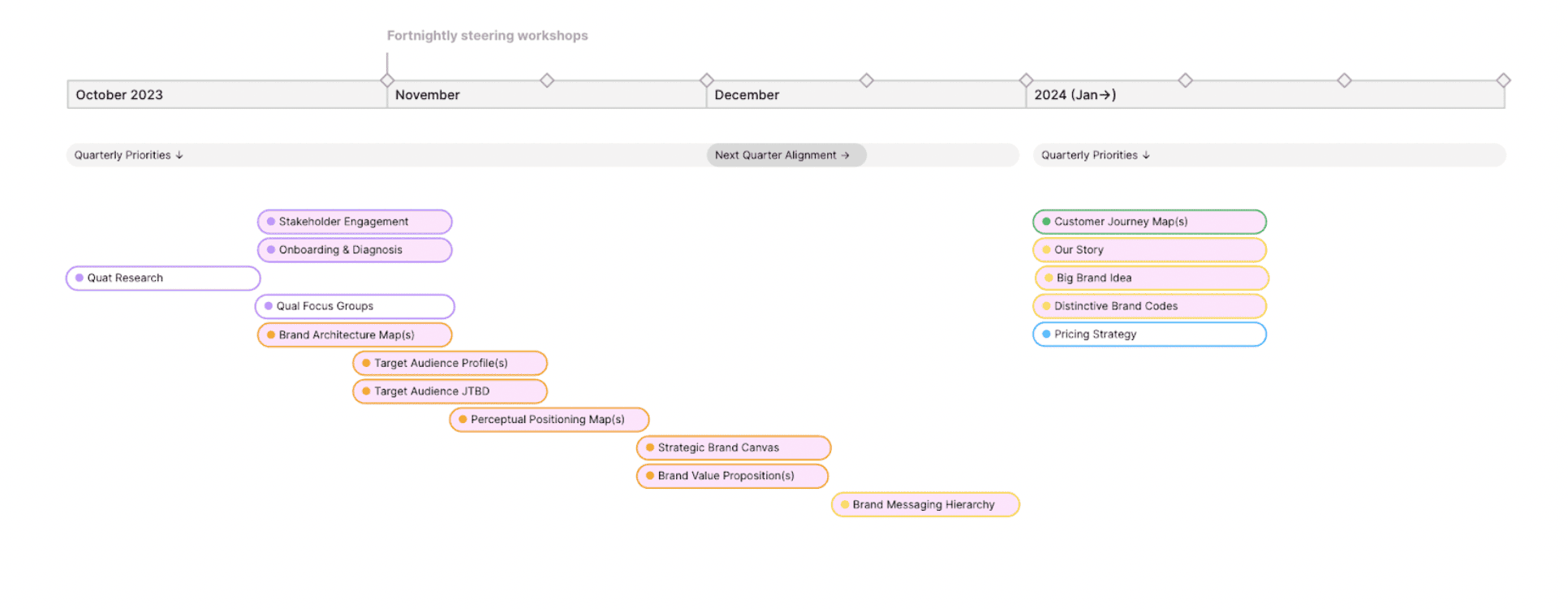
Diagnose > Prioritise > Build > Innovate
Each of the specific projects within the model is underpinned by best-in-class frameworks with actionable outputs. These have been designed as a connected system with the intention of making them more operational and shareable. The intention is to help companies build cumulative value over time, and also to return and optimise or review decisions when changes in the company, customers, or competitor set require it.

The Mindset
The final piece of The Anatomy of Marketing is the mindset. It is possible to apply the model and methodology in your organisation and fall short of realising its full value if it’s done without a mindset that supports it.
In our experience, this is primarily down to true company wide alignment and adoption requiring a certain mindset, which we have summarised with 8 key principles:
- See your business as a living system
- Measure for progress, not procrastination
- Know how it all connects
- Wear hats not titles
- Balance the long and short
- Bring creativity upstream
- Centralise, socialise, and optimise
- Summarise it on a page
The Value of The Anatomy of Marketing
With that being said, what is the full value of The Anatomy of Marketing? It’s a fair question, and we’ve found that it boils down to 4 key elements. It:
- Provides common language and shared understanding of the role and expectations of marketing in your organisation.
- Clarifies customer ownership across all customer touch-points to support a marketing culture across business units.
- Supports focused measurement that is used to make clear decisions and innovate effectively.
- Provides a solution to effectively navigate the complexity of what it actually means to be a “customer-centric” organisation.
All of which, of course, means a business can realise its full potential.
The Authors
Kieran Antill
Kieran is one of Australia’s most awarded brand and marketing experts, having won multiple Grand Prix awards for Creativity and Strategic Effectiveness. He has been the Global Creative Director for Samsung Home Appliances and The Australian Open. Through global executive roles at Leo Burnett, JWT and R/GA, he has led large scale brand development projects for Canon, Google, Diageo, United Nations, WWF and end-to-end Marketing effectiveness projects for numerous National brands and successful scaleups / startups. He has an eMBA and 20 years of experience working across brand development and marketing effectiveness.
Ross Hastings
Ross is a renowned coach, consultant, and academic with a focus on combining behavioural economics, systems thinking, and strategy. Over the last two decades, he’s combined an academic career in the fields of positive psychology and coaching psychology with coaching and consulting for boards and executive teams in business, sport, and academia across four continents. He’s passionate about bridging the gap between theory and practice to develop successful strategies focused on value creation. He’s an Editorial Board Member for the International Journal of Evidence Based Coaching and Mentoring and Journal of Interprofessional Care; has published research on executive team coaching and gender diversity in leadership; and is a member of the Australian Institute of Company Directors.
Publications and Thinking Referenced
Mark Ritson (Various)
Edward De Bono (1985), Six Thinking Hats
Aaron De Smet, Caitlin Hewes, Mengwei Luo via McKinsey & Company (2022), DARE methodology as described in The limits of RACI—and a better way to make decisions
A.G. Lafley and Roger L. Martin (2013), Playing to Win: How Strategy Really Works
Jerome McCarthy (1960), The 4 Ps of Marketing Mix, Basic Marketing: A Managerial Approach
Scott Brinker and Frans Riemersma (2022,) Martech Supergraphic, https://martechmap.com/2023_download
Cheryl Calverley (2023), Marketing Organisations, Currency of Effectiveness series, Marketing Week
